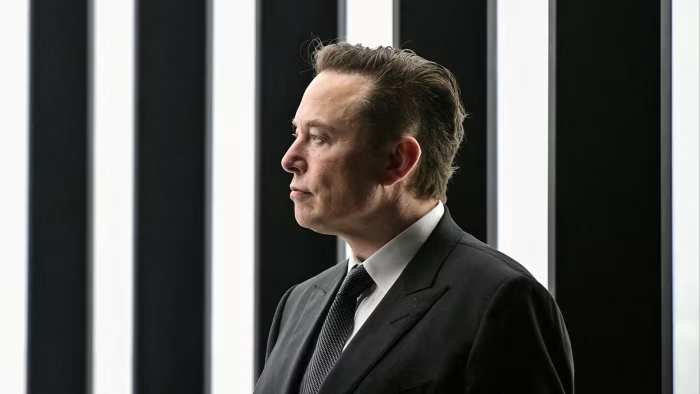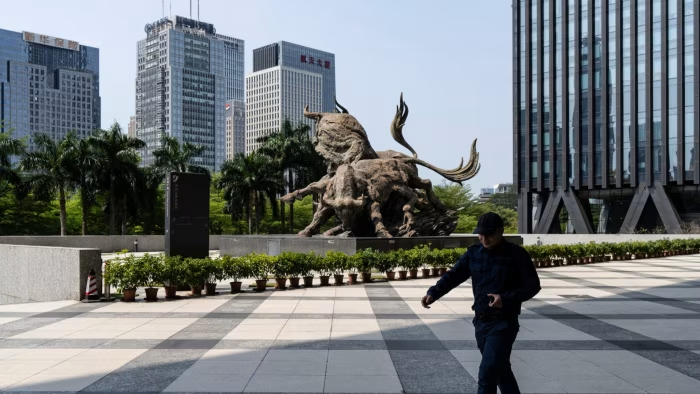Selvaraj defeated Addison Yang Comiskey 6-2, 7-3 before outlasting Yekaterina…
Author: admin
-

Selvaraj, Schwartzman Advance to Quarterfinals at ITA Texas Regional
FORT WORTH — Rice’s Nithesa Selvaraj and Darya Schwartzman each advanced to the quarterfinals in singles play Saturday at the ITA Texas Regional, hosted by TCU. -

World Arthritis Day: Orthopedist lists 5 reasons why women are at higher arthritis risk, says hormones and hips matter
Arthritis, a condition that causes inflammation and stiffness in the joints, affects millions of people worldwide, but it disproportionately impacts women. Studies show that women are nearly three times more likely than men to develop certain…
Continue Reading
-

Vivo officially launches Vivo Y21d
LAHORE – Vivo Saturday announced the official launch of the Vivo Y21d, the latest addition to its Y Series lineup. Designed for young consumers and everyday users, the Y21d delivers long-lasting performance, dependable durability, and…
Continue Reading
-
Diane Keaton, actress and animal advocate, has died, aged 79 – Mongabay
- Diane Keaton, actress and animal advocate, has died, aged 79 Mongabay
- What Diane Keaton Has Said About Never Getting Married E! Online
- Diane Keaton, Famed for Roles in Father of the Bride First Wives Club and More, Dies at 79 (Exclusive)
Continue Reading
-

How to Get Shiny Solosis, Shiny Duosion, and Shiny Reuniclus in Pokemon GO: Shiny Odds, Appearance, Best Tips, and More | Esports News
Completing the Shiny Solosis family in Pokemon GO – featuring Solosis, Duosion, and Reuniclus – requires careful timing, strategy, and participation in special events like the October 2025 Community Day. Financial & markets regulation myFT Digest — delivered directly to your inbox.
US banks are set for an unprecedented easing of capital rules, which new research suggests could unlock $2.6tn in lending capacity and increase pressure on regulators elsewhere to follow suit.
The upcoming dilution of US banking regulation, much of it already signalled by Washington, is likely to free up almost $140bn in capital for Wall Street lenders, according to research by consultancy Alvarez & Marsal.
Since Donald Trump returned to the White House, US authorities have embraced a much more bank-friendly approach, committing to loosen many of the rules that forced banks to increase their loss-absorbing capital buffers after the 2008 financial crisis.
The reduction of capital requirements is set to reinforce the dominant position of big Wall Street groups, boost their capacity to finance huge investments in AI and data centres and allow them to return more capital to shareholders.
“We think the Trump administration is kicking off a major wave of deregulation, unlocking a huge amount of capacity, which will give a massive economic boost and an earnings uplift,” said Fernando de la Mora, co-head of financial services at Alvarez & Marsal.
The New York-based consultancy predicted US banks would benefit from a 14 per cent reduction in their requirements for common equity tier one, a capital buffer that gives them capacity to absorb losses.
It forecast this would result in a 35 per cent boost to their earnings per share and a 6 per cent increase in their return on average tangible common equity — a benchmark used by investors.
The report, due to be published on Monday, provides detailed estimates of the impact of changes to banking regulation across the world. It forecast UK regulators would follow the lead of the US and reduce British banks’ capital requirements by about 8 per cent.
However, it expects EU bank capital requirements to keep rising, predicting a 1 per cent increase, while capital levels for Swiss banks are forecast to rise by up to 33 per cent. The Swiss government has proposed higher capital levels that could require UBS to raise up to $26bn, as authorities seek to strengthen financial stability following the bank’s rescue of crisis-hit rival Credit Suisse.
“This is going to drive a further market share gain by US banks and the UK will just about hold its market share, while the Swiss and the EU banks will lose more ground,” said de la Mora.
JPMorgan Chase, the largest US bank, is set to be one of the main beneficiaries. The easing of restrictions is forecast to release $39bn of its capital, lifting its earnings per share by 31 per cent and its return on equity by 7 per cent.
Michelle Bowman, a longtime critic of stricter bank capital rules, was appointed this year as vice-chair of supervision at the US Federal Reserve and has since committed to ease restrictions that she has blamed for pushing lending into private credit markets.
US regulators have already presented proposals to water down requirements for banks to maintain a preset amount of high-quality capital in proportion to their overall assets.
They have also announced plans to reform the extra capital buffers required of the biggest US banks and to rework the annual stress tests that impose more restrictions on them.
“There is a capital investment boom in the US to be financed — for AI, data centres, energy infrastructure and some reshoring,” said Huw van Steenis, vice-chair of consultancy Oliver Wyman. “This recalibration of regulation will help banks lean into this financing wave.”
However, European regulators worry about the risks of looser bank capital requirements. Christine Lagarde, the European Central Bank president, this month cautioned against “regulatory rollback”, while Bank of England governor Andrew Bailey warned about “the baby being thrown out with the bathwater” when reforming financial regulation.
Continue Reading
-

Elon Musk’s xAI joins race to build ‘world models’ to power video games
Stay informed with free updates
Simply sign up to the Artificial intelligence myFT Digest — delivered directly to your inbox.
Elon Musk’s xAI is pushing to build so-called world models, joining rivals such as Meta and Google in the race to develop artificial intelligence systems that can navigate and design physical environments.
The San Francisco-based start-up hired specialists from Nvidia over the summer to work on these next-generation AI models, which train on videos and data from robots to understand the real world.
World models could push the capabilities of AI beyond that of the large language models, trained on text, that underpin popular AI tools such as ChatGPT and xAI’s Grok.
Two people familiar with the plans said the company was building world models with a view to applying them in gaming, where they could be used to generate interactive 3D environments. One of the people added that they could be applied to AI systems for robots.
xAI has hired Zeeshan Patel and Ethan He, two AI researchers from Nvidia with experience in world models. Nvidia has been a leader in developing this technology with its Omniverse platform, which creates and runs simulations.
Some tech groups have vast expectations of world models, which could unlock uses for AI beyond software and computers in physical products such as humanoid robots. Last month, Nvidia told the Financial Times that the potential market for world models could be almost the size of the present global economy.
xAI would release a “great AI-generated game before the end of next year”, Musk said in a post on X, confirming a target the billionaire set last year.
On Tuesday, xAI launched its latest image and video generation model, which it said had “massive upgrades” and is free to use.
Current video generation models, such as OpenAI’s Sora, generate frames of images for videos by predicting patterns learned from training data.
World models would be a big advance as they would have a causal understanding of physics and how objects interact in different environments in real time.
The company is advertising for technical staff in both image and video generation to join its “omni team”, which “creates magical AI experiences beyond text, enabling understanding and generation of content across various modalities, including image, video and audio”.
Salaries for these jobs range from $180,000 to $440,000. It also has an open position for a “video games tutor”, who will train Grok to produce video games and enable “users to explore AI-assisted game design”, for $45 to $100 an hour.
Musk follows other leading AI labs, such as Google and Meta, that are also working on these systems.
However, world models remain a huge technical challenge. Finding sufficient data to simulate the real world and to train such models has proved difficult and costly.
Michael Douse, head of publishing at Larian Studios, which develops the video game Baldur’s Gate 3, said on X this week that AI could not solve the “big problem” for the games industry, which is “leadership [and] vision”.
He added that the industry did not need “more mathematically produced, psychologically trained gameplay loops [but] rather more expressions of worlds that folks are engaged with, or want to engage with”.
xAI, Patel and He did not respond to requests for comment.
Additional reporting by Hannah Murphy in San Francisco
Continue Reading
-

Embraer predicts challenge to Boeing and Airbus duopoly
Unlock the Editor’s Digest for free
Roula Khalaf, Editor of the FT, selects her favourite stories in this weekly newsletter.
Rising demand for commercial aircraft will create space for rivals to challenge the Airbus-Boeing duopoly, according to the chief executive of Brazilian planemaker Embraer.
Francisco Gomes Neto said he saw the potential for new competitors to produce narrow-body jets, which at present are only built by the European and US companies.
“When I look at the projections for the next 20 years, we see an opportunity for 40,000 aircraft in that segment,” he told the Financial Times at the company’s headquarters in São José dos Campos. “That’s a lot. I think there is room for more than two manufacturers, right? I mean, maybe three or four.”
Embraer is the world’s third-biggest planemaker and dominates the smaller regional jets that carry fewer than 150 passengers, although its output is far behind industry giants Airbus and Boeing.
Francisco Gomes Neto: some of our customers ‘say that they would like to have more options’ © Sajjad Hussain/AFP/Getty Images The $10.6bn group has been studying options for the next generation of its commercial and business jets but Gomes Neto said a decision was not due until the next decade at the earliest because it was focused on selling existing products. Embraer’s latest and largest model, the E195-E2, can carry up to 146 passengers.
Recent crises at Boeing and late deliveries of aircraft from both the US manufacturer and Airbus amid persistent supply chain problems have fuelled talk of whether Embraer might be tempted to enter the single-aisle market.
Gomes Neto said some of Embraer’s customers “say that they would like to have more options”. However, he cautioned that there was a “big gap” between saying something and buying something.
Ron Epstein, a Bank of America analyst, believes there is a case for Embraer to develop a larger aircraft.
“The big question for them is strategically what do they do next?” he said. “Look out over the next 20 years at demand for commercial aircraft and I think almost for sure there’ll be room for a third player,” he added, noting that Boeing’s crises had reminded airlines that “having another player in the market is good for everybody”.
Embraer, Epstein said, was one of the few companies that could “bring a new product to market relatively cost-effectively”.

Embraer enjoys strong demand for its regional jets © Roosevelt Cassio/Reuters Gomes Neto’s comments echo those of executives at Boeing and Airbus, who have said no decisions on whether to launch a new single-aisle jet are imminent. Both are focused on delivering on orders for their existing narrow-body models — Airbus’s best-selling A320 family of jets this week overtook Boeing’s 737 as the most popular commercial aircraft in history by deliveries, according to industry data.
Industry executives believe China’s Comac is the most likely to disrupt the dominance of Boeing and Airbus. The state-owned company launched its first domestically made airliner, the C919, in 2023 and its customers include the country’s three biggest carriers as well as a few overseas airlines.
Going head-to-head with Airbus and Boeing would be a risky endeavour for Embraer. A past attempt by Bombardier to break into narrow bodies almost proved ruinous, leading the Canadian manufacturer to withdraw from commercial aircraft production and focus on business jets.
Gomes Neto said Embraer would not want to put the company’s “financial health” at risk. Embraer plans to almost double revenues from its existing regional and business jets, with a target of reaching $10bn by the end of this decade.
The company is enjoying strong demand for its regional jets despite being subject to the Trump administration’s baseline 10 per cent import tax in its biggest market. It successfully lobbied Washington for an exemption from the additional 40 per cent tariff imposed on Brazil two months ago, with Gomes Neto meeting the US treasury, commerce and transportation secretaries to press its case.
Even so, Gomes Neto said the 10 per cent duty would add about $80mn in costs to the group, chiefly resulting from the import of parts for its private jets that are assembled in Florida. He expressed optimism that the remaining tariff would be removed from Brazilian aerospace goods. Adjusted half-year earnings before interest and tax were $253.8mn.
Embraer has not been immune from the industry’s supply chain challenges. Gomes Neto said deliveries of components such as engines and fuselage parts were still delayed but that the situation was improving, and the company was still on track to reach 100 commercial aircraft deliveries per year by 2028.
He added that the group was pursuing several international sales opportunities for its regional jets, including in India.

Embraer is seeking to boost overseas sales of its military products © Lukas Kabon/Anadolu Agency/Getty Images 
It is also developing battery-powered aircraft that can land and take off vertically © Amanda Perobelli/Reuters The company is also seeking to boost overseas sales of its military products, including the KC-390 Millennium tanker-transport aircraft, and hopes to benefit from higher military spending from Nato countries. Eight European countries have so far ordered the KC-390.
Embraer is working on plans to assemble the KC-390 in the US as part of a bid to win a contract with the US Air Force for the Next Generation Air Refuelling System programme.
Separately, Gomes Neto said he expected the company’s electric air taxi, Eve, to enter commercial service by the end of 2027. The subsidiary, which is seen as a key potential growth area for Embraer, is among several companies developing battery-powered aircraft that can land and take off vertically to take passengers on short-range trips.
Continue Reading
-

Chinese stocks race ahead as reforms take hold
Chinese stocks are outpacing global peers by the widest margin in eight years, in a sign that policymakers’ efforts to revive the market are bearing fruit even as many foreign investors hesitate to return.
The MSCI China index has surged 35 per cent this year, compared with a 14 per cent gain in the MSCI World index of developed market stocks, the largest margin of outperformance since 2017.
This year’s rally comes after many global fund managers last year branded China — whose stock market had been in near-constant decline since peaking in early 2021 — “uninvestable”, following a government crackdown on the private sector and a long-running real estate crisis.
However, Beijing has been pushing to improve corporate governance at state-owned enterprises and private companies, and has launched huge monetary and fiscal stimulus, including measures for financing share buybacks.
Investors say these measures — together with a drive to increase the insurance sector’s equity purchases and concerted buying by the so-called national team of state institutions — are starting to turn the stock market into a viable alternative to property.
“Part of the reason money went into real estate was the stock market was viewed a little bit like Macau,” said Brendan Ahern, chief investment officer at KraneShares, an exchange traded fund provider with products investing in China. He was referring to the tendency for locals to view the market as a casino rather than a place to allocate long-term savings.
“If you can make the stock market an appealing source of returns, it would arguably divert money from going back into real estate. That makes sense for the government,” he added.
Mark Headley, chair of Matthews Asia, an investment manager, said the government viewed the reforms as necessary to help its capital markets compete with the US.
“The Chinese government and the Chinese people have finally recognised that just owning a fifth apartment somewhere is not the perfect savings plan,” he said.
China’s stock market is small relative to its economy. The country accounted for 16.8 per cent of global GDP in 2024 but just 10.3 per cent of global stock market capitalisation, according to the World Bank. China accounts for only 3.35 per cent of MSCI’s all-country world index.
However, the number and quality of Chinese stocks have improved significantly over time, said Archie Hart, a portfolio manager at Ninety One in London. Of the more than 5,000 companies listed in mainland China, 2,504 have a market capitalisation of more than $1bn, according to data provider Wind.
“I look at it on a very long-term perspective. Thirty years ago your choices were state-owned,” Hart said. “Today you’ve got a fantastic choice of ecommerce companies, tech, manufacturing companies, consumer brands.”
Regulators have stepped up their efforts to improve stock market returns and corporate governance at China’s state-owned companies. Measures include tying managers’ key performance indicators to share price performance and return on equity.
When a stock market rout at the start of last year worsened, Beijing brought in Wu Qing, nicknamed the “broker butcher”, as head of the country’s securities regulator in a move to ease volatility and stabilise the market.
In a speech this year, he referred to foreign investors as “important participants in China’s capital market” and said he would accelerate measures to open up capital markets to the outside world.
In September last year, the China Securities Regulatory Commission encouraged listed companies “to lawfully and compliantly use M&A, equity incentives, cash dividends, investor relations management, information disclosure and share repurchases to elevate their investment value”.
“There’s a big effort by the regulators in these agencies to make the mainland Chinese companies credible companies for international investors,” said Amar Gill, secretary-general of the Asia Corporate Governance Association.
But some in the industry see resistance within parts of government to market reforms that could diminish the state’s influence over corporate decision making.
“The tension, I would say, is between the agencies, the regulators and the party,” Gill said. “The party is still wanting to have control of state-owned enterprises and to some extent private companies as well, while the regulators are looking to see how they can make these companies focus on shareholder value.”

China’s outperformance this year comes as global investors seek to diversify their portfolios, which are often highly concentrated in the US.
However, US-China tensions and macroeconomic uncertainty are deterring many from reconsidering mainland stocks, even as Hong Kong proves attractive and other Asian markets such as South Korea and Japan are widely seen as less risky.
“To attract both domestic and foreign investors is going to take two to three years of steady returns,” said Headley.
Foreign flows to China’s mainland market have been muted this year, according to EPFR data tracking ETFs and mutual funds domiciled outside China. Mainland stocks received just $1.2bn of net foreign investment this year.
Some foreign investors remain unconvinced that China’s reforms have gone far enough, with many seeing recent initiatives as signs that Beijing wants to increase its control over companies and markets.
“There is still a huge sceptical slant” in western countries towards China, said the ACGA’s Gill.
Ryan Manuel, managing director of Bilby, which analyses government policy using artificial intelligence, said there was still tension between reforming China’s capital markets and the government’s fixation on controlling strategically vital sectors.
“Industrial policy muscles are stronger than capital markets reform muscles,” said Manuel.
Nevertheless, for Chinese investors, the options are limited. “Where else are you going to put money in China with the real estate market being dead?” Manuel added.
Additional reporting by Haohsiang Ko in Hong Kong
Continue Reading
